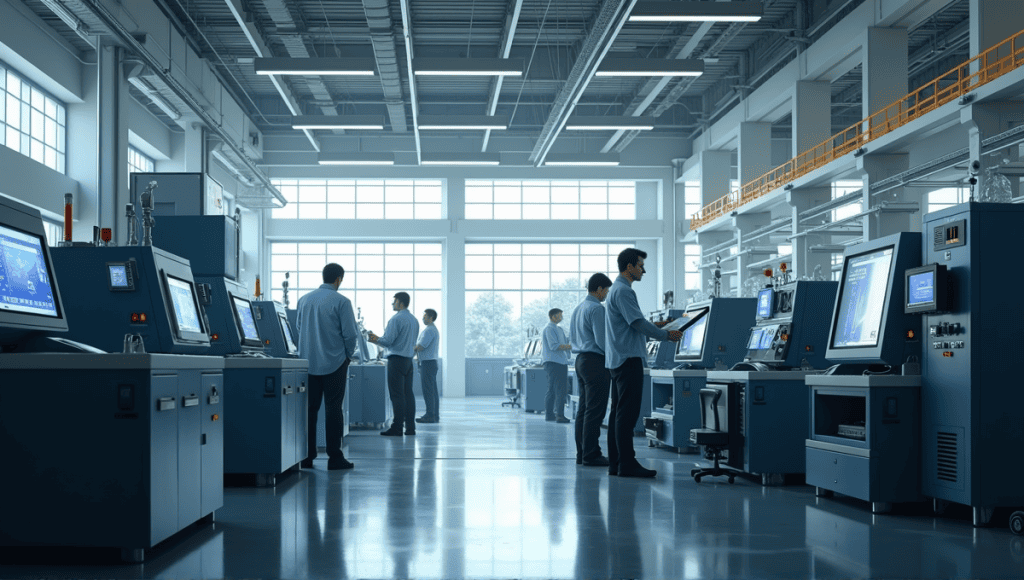Kaizen, the Japanese philosophy of continuous improvement, is adapting to Industry 4.0. I’ve watched many factories fail during the digital transformation. Yet, the reality is that you can use Kaizen with smart technology to optimize your factory. You’ll improve efficiency, reduce waste, and you’ll keep up with the modern manufacturing landscape. So how can Kaizen transform your journey through Industry 4.0?
Kaizen Principles in Industry 4.0

Kaizen and Industry 4.0 may seem like an odd pairing, but in reality, they fit together perfectly. I’ve seen the powerful impact of combining these two methodologies to optimize manufacturing operations. Here’s why you should care.
Digital transformation in manufacturing is challenging. Only 30% of digital transformation efforts in general produce satisfactory results, and even fewer are successful when it comes to Industry 4.0 technologies.
I found these statistics alarming. I also knew there had to be a better way. That’s when I realized Kaizen might be the answer.
After all, Kaizen isn’t just about making small improvements; it’s a mindset shift that can completely change how we think about Industry 4.0. Here’s how:
Continuous Improvement: Think about digital transformation, and always look for ways to improve your smart factory through little changes.
Employee Involvement: Involve your team members in the digital factory transformation, as they probably have many great ideas.
Process Focus: Use data you gather from your IoT equipment to identify bottlenecks in your process and make improvements.
Small Changes: Just as you wouldn’t immediately overhaul the entire production line after buying a factory, avoid making large improvements to digital systems all in one fell swoop.
Customer Focused: Use data analytics and AI to better understand your customers and make improvements that benefit them.
Integrating Kaizen with Industry 4.0 will be a challenge, but it’s well worth it. The key to overcoming digital transformation challenges is to think of Industry 4.0 as a mindset of continuous improvement rather than a large overhaul you have to justify to yourself.
Remember that you’re not just implementing new technology. You’re instilling a culture of continuous improvement within your digital factory.
Smart Factory Implementation of Kaizen

Implementing Kaizen in a smart factory setting is a different ball game – and I’ve helped businesses make this transition. Here’s what I’ve learned:
IoT and data driven Kaizen processes are a game changer. Now, you can identify improvements in real time. Sensors on your production line send data to AI systems. These AI systems then analyze the data and make improvement recommendations faster than you ever could.
AI powered continuous improvement strategies take Kaizen to the next level. Machine learning algorithms can predict potential issues before they occur. This allows you to be proactive, rather than reactive. In other words, you’re no longer just solving problems. You’re preventing them.
Balancing automation with human touch is critical. Robots are excellent at doing the same task 1000 times with the same amount of precision on the first time, but humans are still better at being creative and solving unique problems. Your team should be focused on doing what robots and machines can’t do.
Real-time monitoring in Industry 4.0 lets you do immediate Kaizen. You can see when something isn’t optimized and immediately make a change. This practice substantially reduces waste and makes your entire operation more efficient.
Collaborative robots (cobots) are changing the game in how we implement Kaizen. These robots help your team complete tasks faster without dedicating the man power for quality checks and small tasks that anyone can do.
Below is a comparison of traditional Kaizen versus Industry 4.0 Kaizen:
| Aspect | Traditional Kaizen | Industry 4.0 Kaizen |
|---|---|---|
| Data Collection | Manual, periodic | Automated, real-time |
| Analysis | Human | AI |
| Implementation Speed | Slow | Fast |
| Scope | Limited by human capacity | System-wide |
| Predictive Capability | Basic | Advanced |
This chart illustrates how Industry 4.0 technologies make Kaizen more effective. You can make faster, broader improvements across your entire operation. These improvements can be further enhanced by implementing kaizen in product development to streamline your innovation process.
Benefits of Kaizen in Digital Manufacturing
There are plenty of benefits of implementing Kaizen in digital manufacturing. And I’ve personally seen these benefits materialize in many factories:
- Waste Reduction: Companies using Kaizen report 25-30% less waste.
- Labor Efficiency: Increases by 15-25% when organizations execute Kaizen.
- Quality Improvement: Defects fall 20-40% with Kaizen.
- Overall Productivity: 85% of the manufacturing facilities using Kaizen saw increased productivity.
These are impressive statistics. But what do they mean for you?
The most immediate benefit of using Kaizen in smart factories is higher productivity and efficiency. You’ll produce more output with fewer resources. This is because Kaizen’s continuous improvement philosophy aligns with the data-driven nature of Industry 4.0.
Quality through data-driven Kaizen is another significant benefit. Real-time monitoring and AI analysis catches defects early. As a result, you’ll experience fewer recalls and higher customer satisfaction.
Cost savings and resource utilization are natural outcomes. As you reduce waste and improve processes, you’ll spend less. I’ve seen businesses save millions of dollars with these adjustments.
Employee engagement and a culture of innovation is an often overlooked result. When employees see their ideas implemented, it’s incredibly motivating. This creates a culture of innovation, and you’ll move the company forward through constant improvement.
Problem-solving is much faster in a digital environment. Problems that used to take weeks can now be resolved in hours or even minutes. This agility provides a significant competitive advantage.
Challenges in Merging Kaizen with Industry 4.0
There are a few challenges to merging Kaizen with Industry 4.0. I’ve encountered several challenges as I’ve helped companies make this shift. Here are the main challenges you’ll likely encounter:
Resistance to technology is one of the most common challenges. Many team members are afraid that bringing in more automation will eliminate their jobs. You can address this by:
- Clearly communicating how new technology will benefit them
- Offering extensive training
- Involving employees in the process of implementing new technology
It can be difficult to merge a human-centered Kaizen strategy with automation. The solution is to:
- Use technology to enhance (not replace) people’s skills
- Encourage employees to focus on more strategic tasks that require creativity and problem-solving
- Create regular opportunities for team members to communicate with one another
Data overwhelm and analysis paralysis are common. There’s so much data available that it’s easy to feel overwhelmed. You can solve this by:
- Setting very clear objectives for analyzing data
- Using AI and machine learning to sift through the data and tell you what to prioritize
- Training employees how to think about data and make data-driven decisions
Maintaining a Kaizen culture virtually presents a new challenge. You can solve this by:
- Using digital tools for virtual Kaizen events
- Putting in place a digital suggestion system
- Regularly recognizing and rewarding improvements that team members make while working remotely
Cybersecurity risk in a connected Kaizen system is a very real challenge. You can reduce this risk by:
- Using strong cybersecurity best practices
- Keeping all systems updated and patched
- Training employees how to follow basic cybersecurity best practices
Each of these challenges is significant. However, with the right approach, you can solve all of them. And the benefits of merging the two strategies far outweigh these challenges. Effective kaizen communication can help address many of these challenges by ensuring clear and consistent messaging throughout the organization.
Step-by-Step Guide to Implementing Kaizen in Industry 4.0

Implementing Kaizen in an Industry 4.0 setting requires a systematic process. I’ve walked several companies through this process, and below is a step-by-step process based on my learnings:
- Assess current digital maturity and Kaizen activities
- Evaluate existing technologies and processes.
- What digital capabilities are missing?
- What Kaizen activities are currently taking place?
- Create a digital Kaizen strategy
- What are our objectives? (Ensure they are aligned with a business need.)
- What are our KPIs?
- Roadmap to achieve our strategy
- Train employees on Industry 4.0 technologies and Kaizen
- How can we ensure people know how to use new technology?
- How can we ensure they are applying Kaizen in a digital environment?
- How can we build a culture of continuous learning?
- Execute pilot projects, and then scale your winners
- Start with pilot projects that can solve huge business needs.
- Analyze the results and then iterate.
- Scale the efforts that make the most sense.
- Establish digital Kaizen circles and a suggestion system
- Slack, Teams, etc.
- Suggestion system powered by AI
- Recognizing and rewarding ideas
- Measure and analyze the impact of digital Kaizen
- Try and use the existing infrastructure to track the results of your Kaizen activities.
- We always look at KPIs and then pivot if they’re not moving.
- Share stories about wins and discuss what didn’t work.
The result of this process is that within two years, companies will see:
- 45% decrease in average lead time
- 73% increase in employee engagement
- 65% decrease in operational expense
Just remember this is not a one-time implementation, and you need to continuously tweak what you’re doing to be successful in the long run. Consider organizing regular kaizen events to maintain momentum and drive continuous improvement.
Case Studies: Successful Kaizen in Industry 4.0
Here are a few real world examples of Industry 4.0 Kaizen success stories that you can learn from:
Toyota’s digital Kaizen efforts:
- Implemented AI quality control systems
- Cut defects by 35% within the first year
- Improved production efficiency by 20%
Key takeaway: AI is a powerful upgrade to traditional Kaizen.
Siemens’ smart factory Kaizen success:
- Leveraged digital twin technology to optimize processes
- Slashed machine downtime by 50%
- Boosted overall equipment effectiveness by 25%
Key takeaway: Use digital simulations to speed up Kaizen improvements.
Bosch’s Industry 4.0 Kaizen evolution:
- Rolled out IoT sensors in its manufacturing lines
- Trimmed energy usage by 30%
- Increased productivity by 25% with the same headcount
Key takeaway: IoT data reveals hidden inefficiencies you can improve with Kaizen.
These examples illustrate the opportunity of marrying Kaizen methodology with Industry 4.0. Each demonstrates that with the right strategy, you can make significant progress in efficiency, quality, and cost savings. These case studies serve as excellent kaizen examples that can inspire and guide your own implementation efforts.
Metrics and KPIs for Kaizen in Smart Factories
It’s important to measure the impact of Kaizen in smart factories. Here are the metrics I’ve found most helpful:
| Metric | Definition | Target Range |
|---|---|---|
| Digital Kaizen Participation Rate | % of employees who submit ideas through a digital system | 80-90% |
| Automated Process Improvement Rate | % of processes improved through AI suggestions | 15-25% annually |
| AI Quality Control Accuracy | % of defects identified correctly by AI QC systems | 95-99% |
| IoT Efficiency Improvement | % increase in overall equipment effectiveness (OEE) | 10-20% annually |
| Innovation Index | Ideas implemented per employee, per year | 20-30 |
Key stats to remember:
- 90% of successful Kaizens involve all levels of employees.
- Mature systems see 25 ideas per employee submitted annually.
- 70-80% of submitted ideas are implemented.
- 30% less inventory held in storage.
- 25-35% less time to manufacture products.
- 40% less money spent on quality improvements.
These metrics allow you to track progress and areas to improve. They give a holistic view of your Industry 4.0 Kaizens.
Remember these are general guidelines. You may need to adjust targets slightly based on your specific industry and situation. The most important thing is to select some measurement and start improving
In Summary
Kaizen principles and Industry 4.0 technologies are a formidable duo, and I’ve witnessed the impact of integrating the two to modernize manufacturing processes. You’re equipped with everything you need to improve efficiency, minimize waste, and optimize quality in your smart factory.
Keep in mind that effectively applying these concepts demands commitment, flexibility, and a willingness to learn continuously. While the path isn’t easy, the opportunity to transform your business in the digital era is well worth it. So by implementing these concepts, you’re setting your company up for success in the digital era.






